October 4 - Space Forces Day. 55 years ago, the world's first artificial Earth satellite, which opened the space era in the history of mankind, was launched into a near-earth orbit.
in pursuit of light, of space,
it will at first timidly penetrate the atmosphere,
and then conquer all the solar space. "
Konstantin Tsiolkovsky
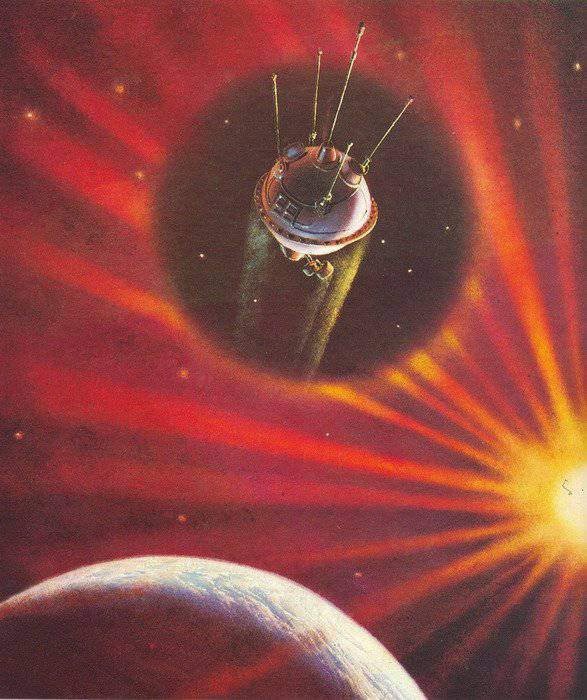
The Versailles Peace Treaty did not prohibit the construction of long-range missiles in Germany. Therefore, after Hitler came to power, a small group of engineers and scientists led by the young and gifted Werner von Braun, having received the support of the army, began active work in this direction. The ideas of designers and inventors Konstantin Tsiolkovsky, Robert Goddard, Hermann Obert found their application in specific systems created by teams of companies Siemens, Lorenz, Telefunken and numerous scientific universities. In 1943, the ballistic missile FAU-2 or Fergeltung, which means Retribution, was created. The rocket marked the birth of unmanned, automatically controlled long-range devices. Immediately after the end of the Second World War, a new, nuclear threat emerged in the world. In the USSR, the atomic bomb delivery systems were quickly developed. 13 May 1946, Stalin approved the decree on the formation of the missile industry in the USSR, which resulted in the creation of a whole committee dealing with jet technology, as well as dozens of new organizations, research institutes and design offices. The old plants were redeveloped, testing grounds were created. The head organization of all work in this area was the Scientific-Research Institute-88 or the State Union Research Institute. By order of the Minister of Defense, Sergey Pavlovich Korolev was appointed General Designer for the development of long-range missiles. This time can be considered the beginning of the creation of an artificial satellite of the Earth (abbreviated AES).
The person who made a significant contribution to the implementation of the idea of going into space was Mikhail Klavdievich Tikhonravov. He had an incredible inquisitiveness - he collected collections of beetles, painted pictures with oil, studied insect flights. Tikhonravov and his small group of like-minded people out of seven people in 1947-1948 have done an enormous calculation work without any computer, having scientifically proved that there is a real version of the missile package capable of accelerating a certain load up to the speed equal to the first space one. Colleagues scientists answered him with ridicule in the form of caricatures and epigrams, and the authorities disbanded the group, lowering Mikhail Klavdievich in the position. However, he was heard by Korolev, who was a great psychologist and realist, realizing that one cannot even stammer about any satellite until there is a rocket capable of putting an end to the atomic blackmail of the Americans. In the United States, Von Braun, who emigrated after the war, was the main ideologue and work leader. In the spring of 1946, his colleagues introduced the Department of Defense to the fact that a rocket to launch a satellite could be created by them by the 1951 year. But, similar to our country, the military department of America was occupied by rockets only for military purposes and refused to give them the necessary funds.
In the 1947, German FAA-2 tests were conducted. In 1948, the first Soviet rocket test site in the town of Kapustin Yar underwent tests of copies of the V-2, already made from domestic materials, called P-1. The series has been developed. In 1950, tests of the P-2 with a range of 600 kilometers began, and in 1953, the P-1200 flew on 5 kilometers. 20 May 1954, a government resolution appeared on the creation of an intercontinental rocket with two stages.
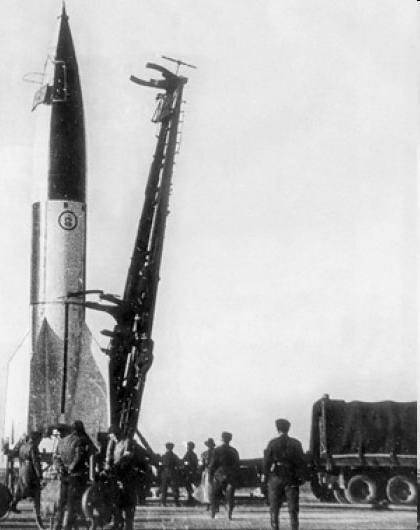
In October of the same year, the International Geophysical Community turned to world powers with a proposal to think about the possibility of launching an artificial Earth satellite for peaceful purposes. Dwight Eisenhower reported that the United States will comply with this request. Our country accepted the challenge. From this point on, all the work on the creation of the satellite was given a green light. 30 January 1956 of the year at a meeting of the Council of Ministers of the USSR approved the decision on the creation of the object D - satellite weighing up to 1400 kg, a draft design of which was already ready by June. The launch year is set to 1957. The eminent scientists of the time, M. V. Keldysh, B. S. Chekunov, N. S. Lidorenko, M. K. Tikhonravov, V. I. Lapko, A. V. Bukhtiyarov and many, worked on the creation of the first satellite under the leadership of Korolev. others. In America, 26 May 1955, the National Security Council also approved the launch of an artificial satellite. Unlike our country, where everything was concentrated in the hands of the Queen, all types of armed forces could carry out work, each of which subsequently presented its own project. A special commission conducted an analysis and eventually stopped between the program of the Naval Research Laboratory for the creation of the Vanguard satellite (Avangard) and the Rand project of the Explorer satellite (the Researcher) developed by Werner von Braun. Brown claimed he could deliver a satellite into orbit in January 1956. If they believed him, then the Americans would launch their AIS earlier than we did. But they did not want the German with the Nazi past to become the “father” of astronautics and a national hero, the choice was made in favor of “Vanguard”.
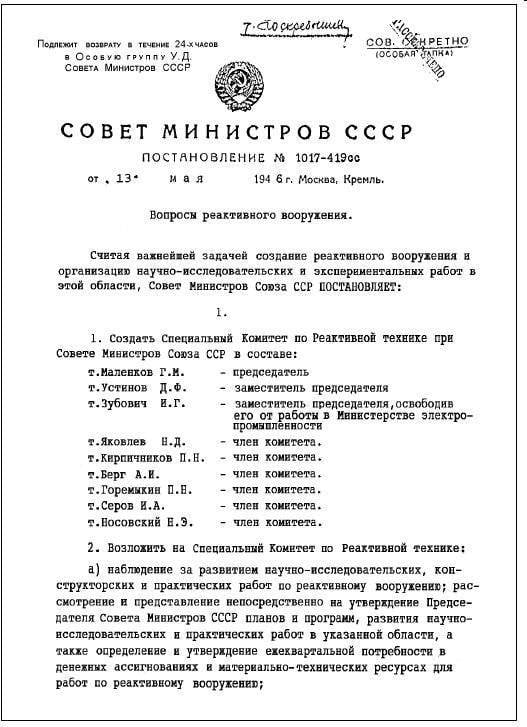
USSR Council of Ministers Resolution No. 1017-419ss of 13 in May of 1946.
Considering the creation of jet weapons and the organization of research and experimental work in this area as the most important task, the Council of Ministers of the USSR decides:
1. Create a Special Committee on Reactive Technology ...
5. Oblige the Special Committee on Jet Engineering to submit for approval to the Chairman of the Council of Ministers of the USSR a plan of research and experimental work for 1946 – 1948, to define as the primary task - reproduction using domestic materials of V-2 (long-range guided missile) and Vasserfal ( anti-aircraft guided missiles) ...
13. To oblige the Committee on Reactive Technique to select from the relevant ministries and send to Germany to study and work on reactive armament the necessary number of specialists in various fields, bearing in mind that, in order to gain experience, Soviet specialists should be attached to each German specialist ...
22. Instruct the Special Committee to submit to the Council of Ministers of the USSR proposals on sending a commission to the United States for placing orders and purchasing equipment and instruments for the laboratories of research institutes for reactive technology, providing for these proposals to grant the Commission the right to purchase under an open license in the amount of 2 million dollars ...
25. Instruct the Ministry of the Armed Forces of the USSR (T. Bulganin) to submit to the Council of Ministers proposals on the location and construction of the State Central Test Site for jet weapons ...
32. To consider the work on the development of reactive technology as the most important state task and to oblige all ministries and organizations to carry out tasks on reactive technology as top priority.
At the end of 1956, it turned out that it would not be possible to prepare object D by the appointed date. Schedule all the time broke. Inventive scientists, who were mostly theoreticians, came to a standstill when it came to production. There was no interaction between science and industry in the country. Korolev was nervous, but Tikhonravov suddenly offered to make the satellite easier and easier. Korolev quickly appreciated the idea, a small object could be made on its own with a minimum number of subcontractors.
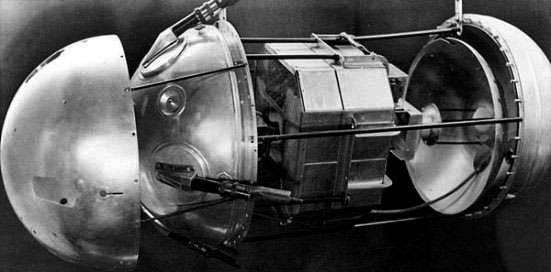
15 February 1957, the decision to put the simplest satellite into orbit (abbreviated PS) was made. Although it was called the simplest, manufacturing took a lot of time and all the forces of the best minds of the country. Pretty quickly, the developers came to the conclusion that it should be done in the form of a ball, diameter 580 mm. The body consisted of hemispheres with docking frames connected with 36 bolts. Rubber gasket ensures tightness of the joint. The satellite was filled with nitrogen. The internal temperature was maintained from 20 to 30 degrees Celsius with the help of ventilation, powered by sensors. Inside the satellite, there were two transmitters with an operating frequency of 20,005 and 40,002 MHz, transmitting a signal with a duration of about 0,3 seconds in the form of telegraph packets. They worked alternately. Antennas were mounted on the outer surface - four rods up to 2,9 meters in length. The power supply of the onboard equipment was provided by silver-zinc batteries. The main difficulty was in the manufacture of semi-shells and perfect polishing of the outer surface. Welding of seams was controlled by X-ray, and a helium leak detector checked the tightness of the assembled container.
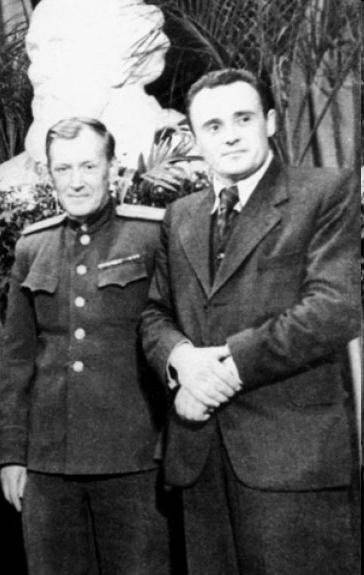
The manufacture of parts went hand in hand with the design. Nevertheless, all systems had time to scrutinize. A system was developed for separating the satellite and the rocket body, which they were able to test on the ground using special equipment that simulated future conditions. But the most important thing is that the launch vehicle has not yet flown.
15 May 1957, the first launch of the new P-7 rocket was made. From the start she left normally. Guided flight stretched for 98 seconds. Then the P-7 lost stability, due to large deviations the engines were turned off. The rocket fell 300 kilometers from launch. The queen was congratulated with success, because on the most important, the first leg of the flight was normal, but he was upset. The second P-7 was prepared, taking into account all the errors, but it never took off because of an error in the installation of nitrogen purge valves. The third P-7 took off normally, but then due to a circuit in the new control unit, all the engines crashed. The rocket collapsed, falling in 7 km from the start. Finally, on August 21 after the fourth launch, the P-7 flew through the entire trajectory. She reached Kamchatka and burned, entering the dense layers of the atmosphere. The last test launch of the P-7 took place on 7 September 1957. All blocks worked fine, but the head part again burned in the atmosphere. According to the results of five tests, it became clear that the rocket can fly, and the head part needs some work. However, to launch the Earth satellite, this did not interfere, since there was no need to enter the dense layers of the atmosphere.
The launch of the first artificial satellite of the Earth took place on October 4 1957 of the year 22 hours 28 minutes Moscow time. The rocket was launched from the fifth research site of the USSR Ministry of Defense, later called the Baikonur Cosmodrome. The “Sputnik” launch vehicle was significantly lightened compared to the standard P-7, the extra equipment was removed, and the automation of engines was simplified. With fuel, she weighed "just" 267 tons. The launch date is considered the onset of a new, space-age humanity, and in Russia it is celebrated as the Day of the Space Forces. This launch was a flight in a place absolutely unknown to humanity. Korolev did not know exactly if the flight path was chosen correctly, where the atmosphere borders. He did not know whether the signals of the transmitter would pass through the ionosphere, sustain the satellite with the impacts of micrometeorites and how the ventilation would cope with the heat removal. When the first data appeared, it turned out that only a split second saved the project from failure. One of the engines went to a preset mode less than a second before the automatic cancellation of the start. And on the 16 second, the system controlling the fuel supply failed, causing the central engine to shut down a full second earlier. This was barely enough to reach the first cosmic velocity.
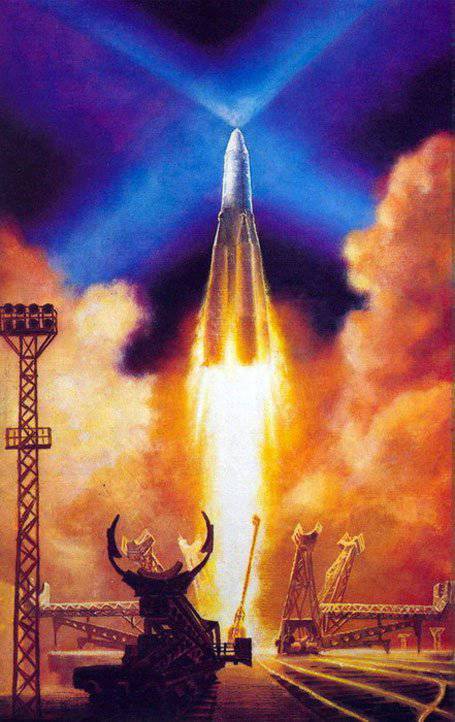
The satellite was in orbit 92 of the day (until January 4), making 1440 turnaround. He made each of them in 96 minutes 10,2 seconds. In the end, due to friction against the upper atmosphere, the satellite lost its speed, entered the dense layers of the atmosphere and burned out. The reaction of the world community was very stormy.
There are no indifferent in any country. Millions of ordinary people across the planet perceived this event as the greatest achievement of human intelligence and will, the most serious breakthrough since the discovery of America by Columbus. The satellite changed the balance of power on the political map of the world. The authority of the United States as a world science and technology leader has shaken. The “space race” has begun.
American journalists wrote: “We didn’t expect a satellite from the Soviets, and therefore it produced the effect of a new technical Pearl Harbor on America.”
"We must work feverishly to find a solution to problems that are already understood by the USSR ... In this race, the prize will be the leadership of the world."
3 November of this year, our country launched a second satellite. It was already a whole scientific laboratory. In space, the dog went Like. The Americans were in a hurry to keep up with us. 6 December saw the launch of their first AES, which ended in complete failure. A couple of seconds after the launch, the carrier rocket dropped. The explosion dispersed the entire launch pad. In the future, of the eleven launches of the Avangard program, only three were successful. It is curious that the first artificial satellite of America was Von Braun's Explorer, launched on January 31 of 1958, after all. Today, satellites are launched in more than 40 countries around the world using their own carriers or purchased from other countries, as well as interstate private organizations.
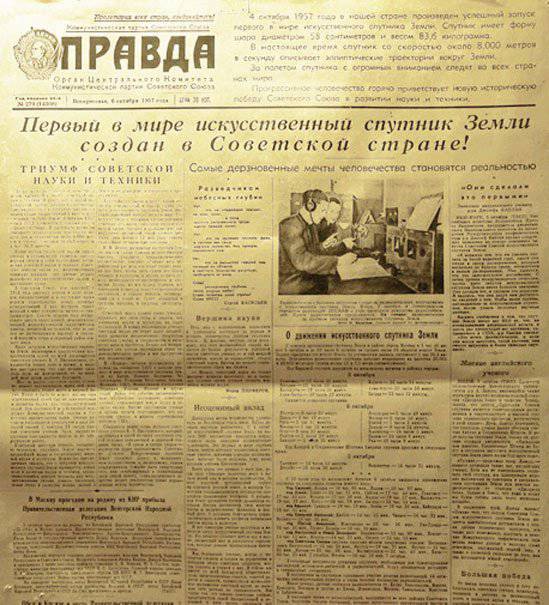
Information